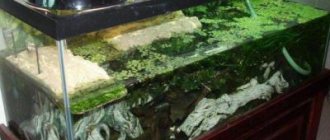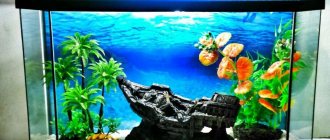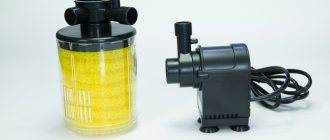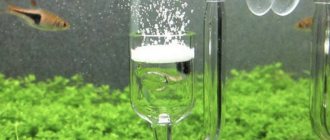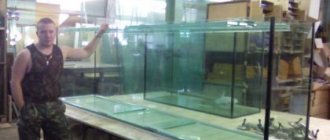A large number of species of aquatic turtles: marsh, red-eared and others need a small, well-heated island of land, since from time to time the turtles need air to breathe, and they also need a place to rest.
Without this, turtles may drown. Also, resting on land is good for the turtle's health; it does not develop some shell diseases. The island should be illuminated with heating conventional and ultraviolet light bulbs. The size of the resting place should be 3-4 times larger than the size of the turtle itself or 2 times larger than the sum of the sizes of all available turtles.
Some species of turtles most like shelters that are under water. If you can make a similar shelter on the island, the turtle will prefer it. Aquatic turtles do not require shelter directly on land.
Do-it-yourself island for a red-eared turtle
The aquaterrarium for red-eared turtles must be properly equipped.
The turtles’ habitat must and definitely include: a spacious body of water and a sufficient amount of land. Red-eared turtles are amphibians. That is, living in water, turtles need to periodically go to land to replenish oxygen reserves and feast on the gifts of nature. Setting up a pond is not that difficult, but building an island for a turtle with your own hands is not an easy task; it requires a competent approach. Article on the topic: Setting up an aquarium for a red-eared turtle (equipment and design)
Description of the species
Ornate turtles (Chrysemys) are divided into eight species. Their representatives live in various bodies of water in South and North America. The most famous of them is the beautiful and slender red-eared turtle.
Its shell reaches 28 cm in length. The pattern on it and coloring are individual for each individual. A characteristic feature of this species is two orange, red or yellow spots that are located on the sides of the head.
These turtles prefer shallow, swampy waters. In their homeland, they are more often called “red-eared sliders” for their special manner of running away from danger at very high speed, sliding their belly along the surface of the soil in order to quickly dive into the water.
"...lonely, like an island in the ocean." Rules for building sushi
If you are setting up a beach for a turtle with your own hands, then the ideal ratio of land and water is 1:4. That is, land should occupy 25% of the area of the aquaterraria. This is provided that the shore or island is no less than 4 turtle sizes. If a whole flock of agile turtles lives in an aquaterrarium, then the land area should be several times greater than the total size of all the turtles.
1. Access to land, that is, a ladder or ascent, should be as convenient and safe as possible. Excessively steep inclines and sliding surfaces should be avoided. The ladder must have a corrugated and rough surface. The angle of elevation should be as obtuse as possible. It will be good if you build an island for the red-eared turtle with your own hands with an angle within 160°.
2. The shore should rise above the water surface by at least 25-50 (mm).
3. The land must be warmed up and exposed to ultraviolet radiation. You can read how to properly organize lighting and heating of the shore in this section .
How to build land?
A shore can be created:
- Based on suspended structure
- With support on the bottom of the reservoir
Suspended structures have a more practical and aesthetic design. That is, a do-it-yourself hanging island for a turtle is a neat and sophisticated island that is created for the pet’s maximum comfort.
The shore supported by the bottom is more massive. Such designs look very natural and natural. Islands supported on the bottom are most often presented in the form of a large stone sculpture, which is simply immersed in a body of water, so that it looks out of the water by 25-50 (mm) and has at least one flat side along which the turtle will climb onto the island .
Article on the topic: How to make an aquarium (aquaterrarium) for a red-eared turtle with your own hands at home
1. If you are creating a suspended bank for a turtle with your own hands, then you can use the following as building material:
- Ordinary glass with rounded edges
- Tile without sharp edges
Why these materials? – The fact is that glass and tiles are completely hypoallergenic materials that do not change the chemical and structural composition of water. If you take plastic or wood impregnated with a water-repellent solution, then the water in the aquaterrarium will slowly but surely be poisoned by all kinds of toxins.
2. If you are building an island for a red-eared turtle with your own hands with support on the bottom, then you can use the following material as material:
- Large pebbles. These are large rounded blocks. You can take not just one pebble, but 3, 4 or all 5
- Solid natural stone
- Granite statue
- corral reef
The advantage of these materials is their natural and natural texture. Stone blocks do not need to be processed or otherwise brought to perfection. The disadvantage of these materials is their massiveness. That is, if the suspended islands do not occupy the space of the reservoir. then the land resting on the bottom of the reservoir takes away precious water space.
Examples of suspended islands
1. If you are building a shore for a turtle with your own hands with a suspended structure, then it is best to fix the island with glue to the wall of the aquaterrarium. This method is the simplest and most effective. But not everyone likes the use of “chemistry” in an aquaterrarium. The fact is that the glue can come into contact with water, which can lead to intoxication of the reservoir.
2. An alternative to glue are vacuum suction cups. But this solution does not have the highest reliability. The suckers may fidget along the wall of the aquaterrarium, or they may completely weaken and drown the land.
3. The glass or tiled surface must be covered with corrugated material with a high level of roughness. Some people install carpet with a plastic backing and non-absorbent pile over a smooth surface. Others, when building an island for a turtle with their own hands, equip the surface with pebbles, which are fixed with glue.
Article on the topic: How many years do land turtles live at home and in the wild?
Primary requirements
How to make an island for a turtle with your own hands, so that the reptile can rest comfortably and safely on it? When preparing such a site, you should pay attention to the following points:
- The size of the island is of decisive importance. It is desirable that its area is several times larger than the size of the turtle. If we are talking about keeping a group of such pets, the area needs to be truly spacious.
- When preparing an island for a turtle with your own hands, you need to consider how easy it will be for your pet to climb onto it. A good solution would be to install a special inclined ladder that is partially submerged in water.
- It is better if the surface of the island is textured. It will be much easier for the turtle to move on a rough surface.
- Making an island for a turtle with your own hands must be strong enough. The platform should not sag under the weight of the reptile.
- It is necessary that the surface of the island always remains above the water level. This will allow the turtle to dry out and warm its body while resting.
- You should not fix the platform at the very edge of the aquarium. The island should be located 15-20 centimeters below its top line. Otherwise, the turtle can get out and run away, getting injured in the process.
- The entire area of the island should be heated with an ultraviolet lamp. The creation of such an alternative to natural sunlight is necessary for the turtle for healthy growth and development of the body. In this case, you need to ensure that the temperature on the island is maintained within 30 o C. After all, the reptile can overheat.
Article on the topic: Keeping and breeding Vietnamese piglets
Glass island
As practice shows, it is quite simple to make an island for a red-eared turtle with your own hands from a piece of durable glass. For these purposes, they take a large piece of material and cut out of it a square or rectangular area, the dimensions of which are several times greater than the parameters of the reptile. The edges of the glass blank are ground and rubbed with sandpaper so that the sharp edges do not harm the pet.
The island is attached to the walls of the aquarium using sealant. The surface of the site is covered with small pebbles using the same composition. This solution will give the island a natural look.
When creating an island for a turtle with your own hands, you should take care of preparing a ladder along which the reptile will climb to the surface. The latter can be a similar piece of glass with the same inlay in the form of pebbles. Alternatively, you can stick a piece of rubber or plastic onto the ladder. The main thing is that the surface of the structure is rough. Otherwise, the reptile will not be able to get out of the water on the slippery surface.
It is not recommended to introduce the turtle into the aquarium immediately after completing the above work. It is necessary to allow all connections of the structure to dry and strengthen. The reptile can be settled after several days. This time will be enough for the sealant to firmly adhere to the surfaces and for the unpleasant chemical odor of the substance to dissipate.
Soil and plants
Depending on the purpose for which the turtle was purchased: as a pet or for breeding for sale, the soil is selected. In the first case, the bottom of the aquarium can be decorated with large stones, since turtles can swallow gravel. When breeding, you will need shallow soil so that the turtle can freely dig through it and lay eggs. You can add a layer of washed river sand.
Aquarium plants are of interest to the turtle; she tries to taste each of them, and if she likes it, the plant will be eaten; if she doesn’t like it, she will pull it out by the roots. Therefore, it is recommended to “plant” artificial plants in aquariums.
Island of stones
How else to make an island for a turtle with your own hands? The least expensive solution in terms of wasted effort and time is to create a platform from large stones. Since the material is of natural origin, it will not harm the pet. Among other things, the stones themselves have a rough surface. Therefore, you won’t have to create any notches or glue them over.
Article on the topic: Toys for guinea pigs: ready-made and homemade (photo)
Before you start decorating the island, you should wash the stones in soapy water, then rinse them thoroughly. Finally, it is worth boiling the material in a saucepan for several minutes. The solution will destroy pathogenic microorganisms that could potentially concentrate on the surface of the stones.
It is recommended to place stones in one of the corners of the aquarium. You need to create a slide with a sloping plane. This is the only way the turtle can get to land without any problems.
What materials are not suitable for creating an island?
When organizing a site in an aquarium, the use of the following ideas does not seem to be a very reasonable option:
- Foam plastic is easy to process, has a rough surface, holds well on water and retains heat. Despite these advantages, the material crumbles easily. Foam particles can get into the water. If a turtle decides to try one of these pieces, it may choke.
- Inflatable pillow - such an island will float well on the water. However, it will be difficult for the turtle to climb on it and hold on.
- A wooden board or driftwood - it’s easy to make an island for a red-eared turtle with your own hands from such materials. The use of natural material will not harm the health of the animal. At the same time, the wooden island will gradually begin to rot. Its particles will get into the water, which will spoil its quality and lead to the need for regular cleaning of the aquarium.
Handling babies
When a small turtle appears in an aquarium, it should be surrounded with maximum care and attention. If you don't pay attention to this delicate creature, it can die.
There are several recommendations on how to care for a small red-eared turtle:
- It is not recommended to pick up babies. Stressful situations for them can result in illness and death.
- Do not stand over the aquarium or knock on its glass.
- The aquarium should not be left in direct sunlight or in a draft.
- The water temperature for babies should be 26-27 °C, the air temperature - 32 °C.
- The water needs to be changed every two days.
- It is necessary to saturate the turtle’s body with calcium.
- Children and adults cannot be kept together.
It must be remembered that many possible health problems in red-eared sliders can be avoided. If you follow the recommendations, this beautiful creature will delight its owner for decades.
Do-it-yourself island (shore, land, raft) and bridge in an aquarium for a turtle
Red-eared turtles spend a significant part of their lives in the water, but also need access to land. In the aquaterrarium you need to arrange a comfortable island, shelf or bridge where the pet will bask under the lamp. A variety of options can be found at a pet store, but if you wish, you can make an island for your turtle with your own hands.
Article on the topic: Roborovsky hamster: description, care and maintenance, distinctive features
Neighborhood
A do-it-yourself terrarium for red-eared turtles allows your pet to be close to aquarium fish. Of course, it is undesirable for them to be in the same “house” - this can provoke frequent conflicts between its residents. In this case, it is better to use a vertical glass wall that will separate the aquarium for the fish and the terrarium for the turtle. There should be holes in the partition so that water can pass freely, but residents of the aquaterrarium should not penetrate through them into the neighbors’ territory.
In the part where the fish will be located, the bottom of the “house” can be decorated with special plants. Don’t bother creating a beautiful design on the turtle’s territory; it won’t appreciate your worries and will happily eat the green spaces.
Important features of sushi
The land area for the turtle should be large enough - no less than 2-4 times larger than the pet itself. If several reptiles are kept at once, the size should be increased accordingly. To independently create a piece of land that meets all the needs of turtles, you need to fulfill the following prerequisites:
- raise the surface above the water by at least 3-5 cm so that the reptile can dry completely after climbing up;
- leave at least 15-20 cm from the surface to the edge of the side of the aquarium so that the pet cannot escape;
- ensure stability and strength - land for red-eared turtles must withstand the considerable weight of these animals, not wobble or fall apart when moving along it;
- use materials that do not contain toxins - glass, food-grade plastic, wood, natural stone, ceramic tiles;
- do not use smooth stones or plastic, from which the turtle can slip - you need to make a rough or embossed surface;
- It is recommended to install a comfortable lift so that the pet can comfortably go onto land;
- Directly above the land you need to place lamps - regular and UV radiation, you also need to leave one corner shaded so that the animal can hide in case of overheating.
When the aquarium is large, the turtle bank is often supplemented with a bridge or raft. This variety will entertain your pet and make his home more interesting. It is important to remember that land in the aquarium should occupy no less than 25% of the total area.
Features of the island for aquatic turtle species
- The turtle should easily climb onto the island, that is, it should be easily accessible.
- To prevent the turtle from sliding, the island, as well as the ladder, must be made rough, not smooth.
- The island should not turn over under the weight of the turtle, that is, it should be strong and sufficiently stable.
- The turtle will be able to warm up and dry on the island only if it rises above the water.
- The dry land should be 20 cm below the top of the aquarium so that the turtle cannot escape and you can safely install the lamps.
- The island should be heated, that is, illuminated with regular and ultraviolet lamps, since ultraviolet rays almost do not penetrate through the water and it is preferable that the temperature on land be higher than the temperature in the water. The temperature should be 30°C.
- The island must be made of a safe and durable material; under no circumstances should you use polystyrene foam or cover the island with small pebbles, otherwise the turtle will swallow them. Do not use silicone caulk as the turtle may eat it.
- The ladder to the island should be slightly higher than the bottom of the aquarium so that the turtle does not get stuck between the ladder and the bottom of the glass aquarium and drown.
- A piece of glass with large stones glued to it is best suited for an island.
You can make different versions of the islands yourself, order them from an aquarium workshop, or buy them from a pet store:
Sushi options
Before you go looking for materials, you need to decide on the type of future land plot. There are several basic designs:
- Hanging - most often, shelves and other hanging devices that are attached to the walls of the aquarium above the water level, a ladder must be attached to them.
- Supporting — installed on the bottom (various islands for turtles, bridges, slides), must be heavy and strong enough so that the pet does not move the device along the bottom.
- Bulk - part of the aquaterrarium is separated by a partition and covered with sand or pebbles, this method allows you to create a spacious area of \u200b\u200bland for the turtle.
- Floating - usually these are small structures, but with the help of modern materials even a large raft can be made. The disadvantage of such a device is its mobility and “sinkability” - it can be used for cubs and growing individuals.
Article on the topic: Water temperature for red-eared turtles in an aquarium, how many degrees is optimal?
When choosing a design, it is better to be guided by the conditions of a particular aquaterrarium. In small containers, it is recommended to use hanging and floating models so as not to reduce the total area available to the pet. If the aquarium is large, you can make a wooden bank for the red-eared turtle or install a reliable stone island.
UV lamp
Depending on the age of the turtles, the power of the UV lamp is selected:
- for young individuals – 5% UVB;
- for adults – 10% UVB.
The presence of an ultraviolet lamp is the main condition for the normal development of red-eared turtles. To prevent animals from getting eye burns, the UV lamp should be installed at a level of at least 25 cm and turned on for 10-12 hours, turned off only at night.
Ultraviolet radiation prevents the development of rickets, improves metabolism, and affects the activity of turtles. The rays help absorb calcium, which is necessary for building the shell.
DIY shelf
One of the simplest sushi options is a shelf that is glued to the walls. To do this, you will need a suitable size piece of thick food-grade plastic, wood, tile or 6 mm glass.
Glass cutting is performed with a special oil glass cutter; you can also purchase a piece of the required size in a workshop. To make a hanging nest for a red-eared turtle with your own hands, you will need silicone glue-sealant. To do the job, you need to follow the step-by-step instructions:
- The edges of the shelf should be trimmed evenly and sanded with sandpaper - it is better to grout the glass under a stream of water to avoid inhaling small particles.
- The water is drained from the aquarium, the walls are thoroughly washed to remove plaque, and the place where the shelf is attached is degreased.
- The aquaterrarium is placed on its side, the edges of the shelf are covered with sealant.
- The shelf is applied to the walls and pressed tightly for several minutes so that the glue sets.
- The part is fixed with masking tape and left to dry completely for a day.
- For a heavy tiled shelf, it is better to immediately glue in a support - a vertical piece of plastic or tile that will rest on the bottom.
To make it convenient for your pet to go onto land, the shelf is attached at a slight angle, or a plastic or glass ladder is glued. Its lower edge is not lowered to the bottom - this way the reptile will have enough space to swim. The surface of the descent and the land itself must be lubricated with sealant and sprinkled with clean sand. You can glue pebbles onto land; small glass beads will also work. Shelves with artificial grass made of plastic look beautiful; a soft green rubber mat will be an analogue. These methods will help make the surface of the shelf textured and the turtle will not have difficulties moving on land.
Article on the topic: How to make a booth for a German shepherd: rules for measuring the animal, drawing up a drawing and manufacturing technology
IMPORTANT: In order not to worry about a rough surface, you can find decorative tiles with a relief pattern. Convex lines and stripes will create a sufficiently textured base so that your pet’s paws do not slip, and such a surface will be easier to clean than one covered with pebbles.
Video: making your own shelf from a disc cover and a cork
Homemade stone island
To make a stone island for your aquarium yourself, you will need to select pebbles or stones of a suitable size (at least 4-5 cm). It is better to choose flat stones with a rough surface. They need to be pre-treated at home - boiled over low heat for half an hour to kill all bacteria.
You can make an island for a turtle with your own hands from stone without the use of additional materials and tools. The water is drained from the aquarium and several layers of pebbles are laid out in one of the corners to create a slide of the required height. To stabilize the structure, you can use sealant, but it is better to choose stones that are flat enough to be held in place by their weight. They can be disassembled and washed when cleaning the aquaterrarium.
Decorative version of the island
An island for a red-eared turtle can not only serve as land, but also become a real decoration of an aquaterrarium. To make it, you can use dried and processed parts of coral masses, pieces of granite or wood, pick up bright pebbles or glue pebbles to an island of different colors. When laid out in a certain sequence, they will create an elegant pattern reminiscent of a mosaic. You can also use plastic plants, colored glass granules, and shells to decorate the surface.
Homemade bridge
The island can be made more impressive by building something like an arch made of stone or wood. This way you can create a beautiful bridge for a turtle, which will give your pet’s home an exotic look. It is better to use a large piece of plastic or plexiglass for the base of the structure. To make a bridge for a red-eared turtle with your own hands, you will need silicone sealant. Flat stones or pebbles are carefully laid out layer by layer, each piece is secured with glue. The height of the structure should be such that it protrudes several centimeters above the water, and the width should exceed the diameter of the animal’s shell. When the bridge to the aquarium is ready, you need to leave it to dry for 1-2 days.
Article on the topic: What kind of water does a red-eared turtle need, how much to pour into the aquarium when keeping it at home
You can also make a bridge from wood - for this you use even blocks or neatly cut pieces of bamboo. It is also better to fasten them with sealant - the nails can rust from constant exposure to water.
Proper diet for turtles
In captivity, the red-eared turtle should be fed with low-fat, preferably river fish, and once every two weeks the freshwater reptile is given raw beef liver. The diet of an exotic pet must be supplemented with snails, as well as crickets, food cockroaches, earthworms and small aquarium fish. The plant part of the diet can be represented by various aquarium plants, lettuce, dandelion and plantain leaves.
Aquarium water should contain calcium in the form of Vitakraft Series mineral stone. Many owners of red-eared turtles feed their pets with special ready-made diets: Tetra ReptoMin, Sera and JBL. Among vegetable crops, preference should be given to carrots, which in crushed form are given to freshwater reptiles no more than once a month. A tortoise under one year of age should be fed daily, while older turtles should receive food once every two or three days.
Raft for turtle - floating shore
Floating structures are convenient because they save space, are easily removed and do not interfere with cleaning the aquarium. You can make them yourself from scrap materials - plastic, cork. But it should be borne in mind that this type of sushi is only suitable as a temporary option. It is best to make a comfortable and reliable raft for your pet from wood or bamboo.
The material must first be treated with moisture-proof impregnation and varnished - then the wood will not rot from constant exposure to water. Vacuum suction cups can be used to secure the turtle raft under the lamps. You can buy them at a hardware store, and to glue them to the edges of the raft you will need silicone sealant.
IMPORTANT: When choosing treatment products, you must check that they do not contain harmful or toxic substances. Impregnations that are used for wood in a sauna or bathhouse are well suited.
